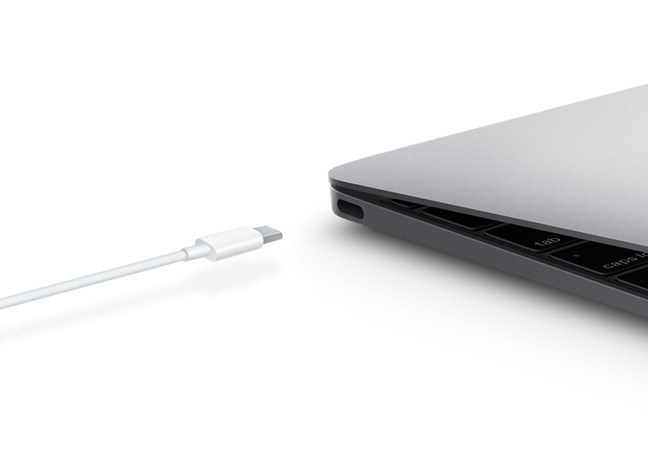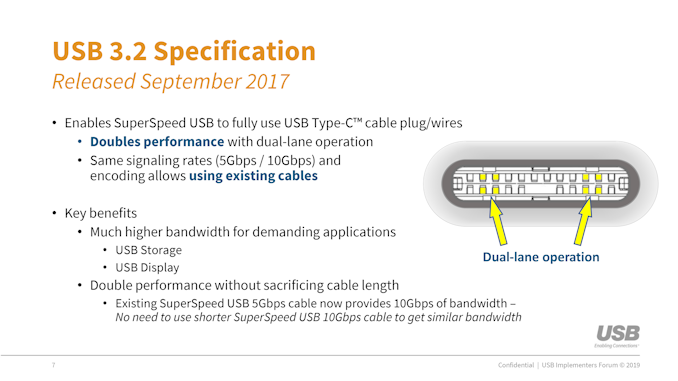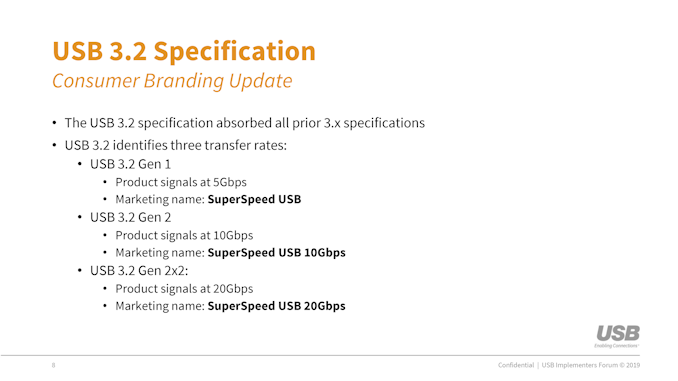USB 3.2 at 20 Gb/s Coming to High-End Desktops This Year
by Anton Shilov on February 26, 2019 1:00 PM EST- Posted in
- Peripherals
- Trade Shows
- USB-C
- USB
- ASMedia
- USB 3.2
- MWC 2019
- Synopsys

Since mid-2017 we've been talking about the impending arrival of USB 3.2, the next version of the USB Implementers Forum's ubiquitous standard for connecting external devices. With 3.2 serving as both an upgrade to the feature set and a physical layer tweak to provide more bandwidth, according to the USB-IF at MWC 2019, the technology will finally come to fruition this year.
According to the organization that sets the standards for the USB interface, discrete USB 3.2 controllers capable of supporting the standard's new 20 Gb/s Type-C mode will be available this year. Being a specification-setting group, the USB Implementers Forum does not name companies that develop actual chips. But given the limited number of companies that develop standalone USB controllers, the names of the suspects are pretty well known.
Since discrete USB controllers are used mostly by high-performance desktop systems, we're likely to see the first USB 3.2 chips to land on high-end motherboards first. In which case we could see motherboard venders showing off product sometimes this summer, or maybe a bit later. Meanwhile peripherals will likely lag a bit for compatibility testing and the like, in which case we'd start seeing them in 2020.
Though technically only a point upgrade for the USB standard, USB 3.2 includes multiple enhancements for the standard in terms of bandwidth, as well as changes to how the standard is branded. In terms of bandwidth, USB 3.2 introduces the ability to use two high-speed USB Type-C Tx/Rx channels – the so-called x2 mode – to get 20 Gbps maximum throughput on a Type-C cable. The technology retains the USB 3.1 physical layer data rates and encoding techniques (SuperSpeed and SuperSpeed+), so while bonding two channels is new, how those individual channels work at a low-level is not.
Meanwhile, USB 3.2 branding will be absorbing the earlier USB 3.0/3.1 branding, as the overriding USB 3.x standard continues to evolve separately of the underlying SuperSpeed encoding technique. As USB 3.2 hosts and devices roll out on the market, we’ll see the branding switch over to USB 3.2 Gen 1 (5Gbps SuperSpeed), USB 3.2 Gen 2 (10Gbps SuperSpeed+), and USB 3.2 Gen2x2 (2x10Gbps SuperSpeed+). So while all future products will be 3.2, they won't necessarily support the higher 10Gbps and 20Gbps data rates. Those decisions are up to the device manufacturer, especially as not all devices need the higher speed modes and the increased build costs that come with them.
Related Reading:
- ASMedia Demos USB 3.2 Gen 2x2 PHY, USB 3.2 Controller Due in 2019
- USB 3.2 Update to Bring 20 Gbps Bandwidth: USB 3.1 Type-C Cables Compulsory
- Cosemi Launches USB 3.1 Gen 2 Hybrid Active Optical Cable: Up to 50 Meters of USB
- Cypress and Zhaoxin Have USB 3.1 Gen 2 USB Controllers
Source: USB Implementers Forum












62 Comments
View All Comments
peevee - Tuesday, February 26, 2019 - link
It should, regardless. And charge at 20V 5A at least for the first 50%.Ashinjuka - Tuesday, February 26, 2019 - link
USB-IF should be ASHAMED of themselves for this unabashed marketing fuck-everyone-on-earth-except-us bullshit naming scheme.Dug - Tuesday, February 26, 2019 - link
Takes a long time to make the specification.A bunch of guys sitting around a table and they say, hey lets double the bandwidth!
Job done.
Next 2 years will be same guys saying, hey lets double the bandwidth!
They still have to wait to see if someone is capable and willing to make it.
SteelRing - Tuesday, February 26, 2019 - link
I'm going to stop buying sh1t until our great orange leader declares we are ready for USB7 and 6G... wTH people, get your act together... I already have 3 different cables I have to keep around the house today.... geezjhoff80 - Tuesday, February 26, 2019 - link
I'm trying to wrap my head around the way these lanes work.Is it correct that this Gen 2x2 (20Gbps) only works with no video out? And then with 2 lanes for DP you're kicked back to 10Gbps, and if you need 4 lanes for DP (like if you're using 4k with DP 1.2) you're kicked all the way back down to 480Mbps?
Or are these different lanes that it's using (is it maybe taking over the USB 2.0 lanes and making them highspeed?) and this is still compatible with DP Alt mode?
repoman27 - Tuesday, February 26, 2019 - link
That is exactly correct. There are 4 high-speed differential signaling pairs as well as a USB 2.0 data pair in a USB Type-C cable. SuperSpeed USB lanes require 2 high-speed pairs (1 Tx + 1 Rx). DisplayPort Alternate mode can use either 2 or 4 of the high-speed pairs to create a 2 or 4 lane main link (all one direction). So you can have USB 3.2 Gen X x 2, USB 3.2 Gen X x 1 + 2-lane DP main link, or USB 2.0 + 4-lane DP main link.namechamps - Wednesday, February 27, 2019 - link
Your first example is correct. To be clear usb-c has 4 high speed lanes (10 Gbps ea). It also has usb 2.0 lanes, power and data pins, and sideband configuraiton channels but lets ignore those. You have 4 lanes. The 4 lanes have always been there since usb-c was released. So you can have 4 lanes of displayport + usb 2.0, 2 lanes of displayport + 10 Gbps USB (1 lane each way), or 20 Gbps USB (2 lanes each way).ceisserer - Friday, March 1, 2019 - link
I simply can't believe this naming scheme wasn't deliberately chosen to confuse customers.eastcoast_pete - Sunday, March 3, 2019 - link
@Anton: I am a bit late to this party, but maybe you or somebody here has the answer to this: how quickly does USB 3.2 transmission speed degrade with increased cable length?For me, one of the biggest letdowns of previous USB generations was/is that you only get really fast transmission with really short cables (50 cm or less). So, what happens to transmission speed with USB 3.2 certified cables if I have to use a 1.5 m, 2 m or 3 m cable? Would be a real advance if they (USB standards group) finally addressed that performance degradation in their specs.
dontlistentome - Monday, March 4, 2019 - link
Most commentators are utterly overreacting to this, claiming consumers will be confused. If the cables fit most consumers don't care.USB use: charging phones and stuff: 90%. Wireless keyboards and mice: 8%. Geeks running benchmarks on their external SSDs: 2%
More speed is good, and multiple updated standards is the way of the world now. As long as they stick to the USB C connector for the next 20 years or so, 99.9% of people will be happy because stuff will just work, and in most cases work perfectly well enough.